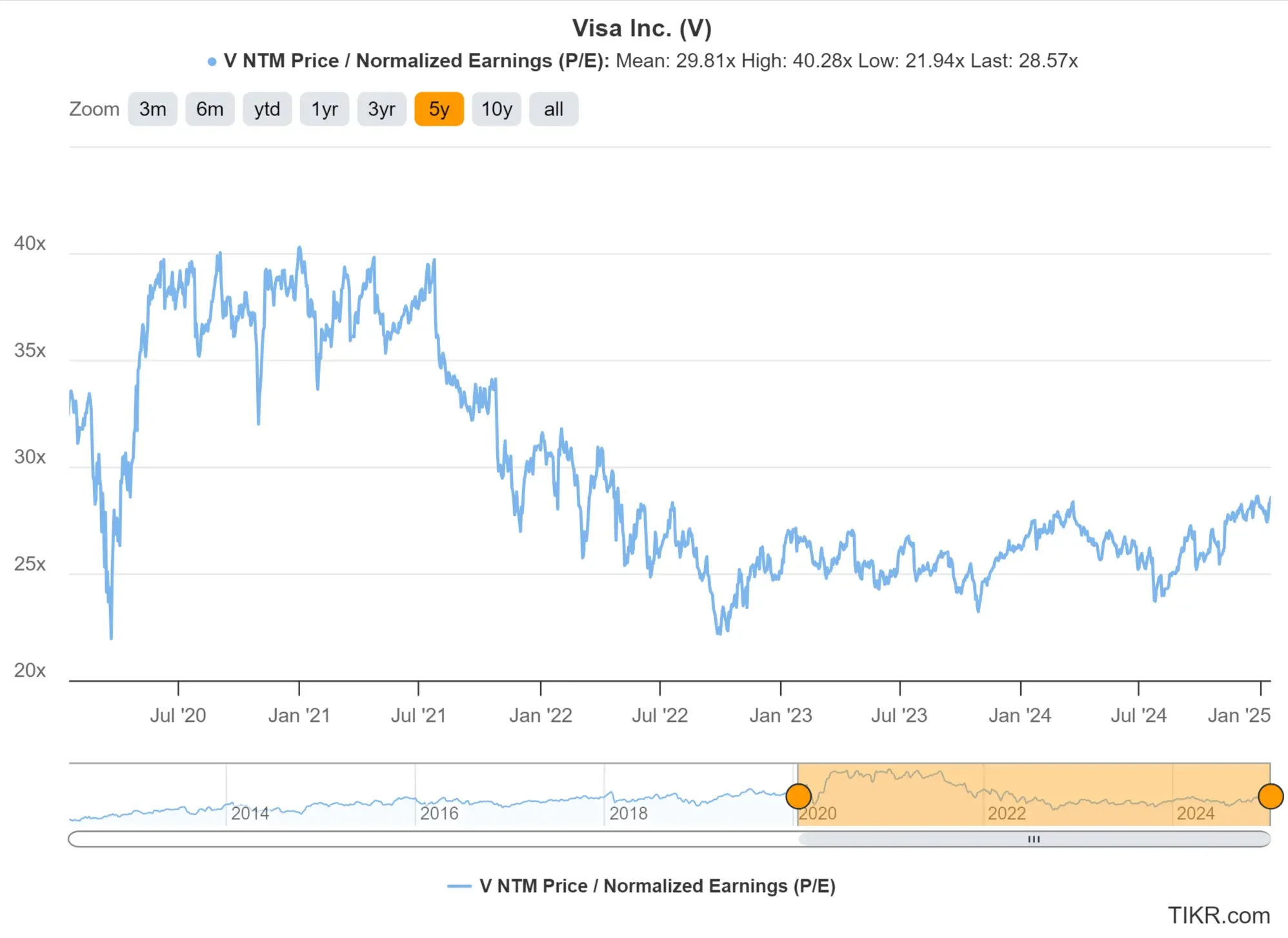Key Takeaways:
- The 2-Minute Valuation Model values Visa stock at $483 per share in 2.75 years.
- That’s a potential 50% upside on one of the world’s best buy-and-hold stocks.
- Get accurate financial data on over 100,000 global stocks for free on TIKR >>>
Visa ($V) stock has risen 17% per year over the past decade, while the market averaged around 11% annual price returns. This has led to Visa stock nearly doubling the market’s total return over the past decade.

Visa is one of two dominant players in the global payments duopoly, alongside Mastercard (MA).
Its business is highly profitable, with strong margins and excellent returns on capital.
Additionally, Visa also benefits from trends such as growing consumer spending, the shift to digital payments, and global economic growth.
Right now, the stock looks undervalued and could increase 50% in the coming years.
We also like Pfizer, ASML, and Microsoft today. Find the best stocks to buy today with TIKR! >>>
What is the 2-Minute Valuation Model?
There are 3 core factors that drive a stock’s long-term value:
- Revenue Growth: How big the business becomes.
- Margins: How much the business earns in profit.
- Multiple: How much investors are willing to pay for a business’s earnings.
Our 2-Minute Valuation Model uses a simple formula to value stocks:
Expected Normalized EPS * Forward P/E ratio = Expected Share Price
Revenue growth and margins drive a company’s long-term normalized EPS, and investors can use a stock’s long-term average P/E multiple to get an idea of how the market values a company.
Is Visa Undervalued?
Forecast
On Visa’s Analyst Estimates tab shown below, you can see analysts expect the company to grow revenue at an 11% compound annual growth rate over the next 3ish years, while normalized earnings per share, or EPS, are expected to grow even faster at a hair over 15% per year:

View Visa’s full analyst estimates >>>
For context, over the past 5 years, Visa’s revenue grew at 9.4% per year, while earnings grew at 13.1% per year.
That means analysts expect Visa’s growth to speed up slightly in the coming years, which means the stock could continue to trade at a premium valuation multiple.
Valuation Multiple
Visa stock currently trades at around $322/share, which means the stock trades at nearly 29 times next year’s expected earnings.
Over the past 5 years, the stock has averaged a 30x P/E multiple, so the stock is trading right around its historical average.
We’ll use a 28x P/E multiple in our valuation to be a bit conservative.

In today’s market, many wide-moat, blue-chip companies are trading at P/E multiples that are double their expected earnings growth or even higher.
Put simply, investors are paying a premium for high-quality American companies.
With Visa projected to see 15% annual earnings growth, a 28x P/E multiple isn’t cheap, but it seems justified.
Given these fundamentals, there’s a strong case that Visa might be undervalued today.
Fair Value
3.75 years from now, analysts estimate that Visa could reach about $17.05 in normalized EPS. At a 28x NTM P/E multiple, that values Visa stock in 2.75 years at $477/share.
(The NTM P/E multiple uses the expected earnings for the next twelve months, so a 2.75-year valuation uses 3.75-year EPS forecast figures. Additionally, we’re using three-quarter-year figures in this calculation because Visa’s fiscal year ends in September.)
We can tack on an extra $6/share for the dividends that Visa is expected to pay, which brings the stock’s total fair value to $483/share.
With the stock trading at about $322 today, this implies that the stock could rise nearly 16% per year over the next 2.75 years, or 50% in total:

For reference, the stock market has averaged 10% annual returns over the long term.
So, 16% annual returns for a high-quality, capital-compounding business like Visa would be awesome.
This means Visa could continue delivering high returns, as it has in the past decade.
However, analysts don’t see much upside for Visa stock.
Analysts’ Price Target
The consensus price target for Visa is currently $339/share, based on estimates from 36 analysts. This suggests analysts think the stock has just over 5% upside today.
Over the past 5 years, when analysts thought Visa stock had upside to reach its fair value, the stock tended to perform well.
The blue line below shows analysts’ estimated upside for Visa stock over the past 5 years.
When the blue line was high, analysts thought the stock was undervalued. When the blue line was low, analysts thought the stock was overvalued.
The black line simply tracks $V’s stock price, which has climbed pretty steadily over the past 5 years.

Find the best stocks to buy today with TIKR >>>
TIKR Takeaway
Using the 2-Minute Valuation Model, Visa stock appears undervalued and could deliver 16% annual returns over the next 2 years.
Of course, this is just a valuation exercise. No one knows where a stock is headed in the short term, and few can predict where a stock is heading in the long term.
The TIKR Terminal offers industry-leading financial data on over 100,000 stocks and was built for investors who think of buying stocks as buying a piece of a business.
Disclaimer:
Please note that the articles on TIKR are not intended to serve as investment or financial advice from TIKR or our content team, nor are they recommendations to buy or sell any stocks. We create our content based on TIKR Terminal’s investment data and analysts’ estimates. We aim to provide informative and engaging analysis to help empower individuals to make their own investment decisions. Neither TIKR nor our authors hold positions in any of the stocks mentioned in this article. Thank you for reading, and happy investing!






